Chris Baty's Blog, page 136
November 5, 2016
30 Covers, 30 Days 2016: Day Five

Every November, during National Novel Writing Month, thirty professional designers volunteer to create book cover art inspired by novels being written by aspiring authors from around the globe. Why? To encourage new, diverse voices, and help build a more creative world.
30 Covers, 30 Days is presented in partnership with designer and author Debbie Millman.
Read more about these NaNoWriMo 2016 novels-in-progress, and the cover designers, below.
Regard the Skies
A science fiction novel being written this November by
Eileen Emanon
in the United States.
Jayleen Khan is an optimistic, high-flying renegade. She’s a hacker and info-leaker-for-hire alongside her nine-year-old sidekick, Sora. With the help of Jayleen’s childhood friend, Vinn, and his hotshot pilot grandmother, Nonna, the team is determined to get to the bottom of a conspiracy that involves a secret factory, missing children, and the most powerful corporation in the galaxy: Atheon.
It’s a mission that will take the crew across the galaxy to the dusty streets of a post-revolution Mars, giant metropolises, sleezy clubs, dazzling starships, and every bit of space in between, all while being pursued by sinister agents sent by Atheon themselves.
Cover Designed by Alice Ventura
Alice Ventura is a freelance concept artist who specializes in environment design. She is extra nervous and really loves the color green. Her favorite pass times include (but are not limited to) writing, painting, and sleeping in on rainy days.
November 4, 2016
30 Covers, 30 Days 2016: Day Four

Every November, during National Novel Writing Month, thirty professional designers volunteer to create book cover art inspired by novels being written by aspiring authors from around the globe. Why? To encourage new, diverse voices, and help build a more creative world.
30 Covers, 30 Days is presented in partnership with designer and author Debbie Millman.
Read more about these NaNoWriMo 2016 novels-in-progress, and the cover designers, below.
Queen’s VowA fantasy novel being written this November by Nor Iben Narten in Norway.
Revolution is messy.
Marble City is host to many wizards, from herbalists in the town square, to mad alchemists in the forest. Home-taught, friend-taught, it’s always been a culture with tradition.
When the Queen orders all who practice magic to be strictly supervised and taught for the benefit of the military, wizards and witches retaliate immediately. Not just with magic: Guns, assassinations, massacres, anything to get the Queen’s attention. But she sits prettily in her ivory tower, no dirt under her nails, no blood on her hands.
But not for long. Not for long.
Steve Baust is a communications designer focused on making tangible things that are exciting and memorable. He is passionate about finding non-traditional solutions to design problems. Steve’s work spans print, web, photography and illustration. He is currently a designer at ThoughtMatter, a branding and strategy studio in New York City.
The 5 Stages of Writing: How to Channel Your NaNoWriMo Feels Into Your Novel
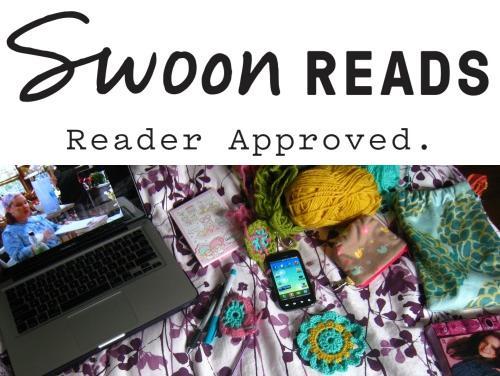
Every year, we’re lucky to have great sponsors for our nonprofit events. Swoon Reads, a NaNoWriMo 2016 sponsor, is a community-based publishing platform for YA fiction. This year, they’re offering Wrimos the chance to win one of fifty reader-approved goody boxes. Today, they’ve shared with us the best ways navigate the 5 stages of writing throughout the month:
You’ve committed. You’re going to write a novel in 30 days. And you have THE BEST IDEA EVER. This is going to be a breeze. Best-seller author status, here you come.
We guarantee the month will start out great. You’ll wake up early, carry a brand-spanking-new notebook around with you, talk to all your friends about your brilliant idea. You’ll probably even go to a write-in. And of course, you’ll check your completion graph OBSESSIVELY.
But the thing is, writing is almost never as easy as it seems.
Here at Swoon Reads, we know from experience that sometimes writing is more akin to grief than glory. So we’ve outlined exactly how you can use all those feels to write the best first draft of your novel possible when you’re in the darkest throes of NaNoWriMo angst.
Stage 1: Denial.So you didn’t make your word count this week. It’s cool. You still have three whole weeks to make it up. No biggie.
What you do: You think about adding a subplot. Or changing the main character’s name. Or adding a new character–a villain. MAYBE TEN VILLAINS. The subplot can include the ten villains! These new bad guys will totally help you hit your word count. You could write about them all day.
Wait. Why is the mob of villains making out?
What you should do: Make time. And if you are excited about a change you want to make in your novel, go with it. Anything that keeps you interested in getting words on the page, even if it doesn’t fit with your original plan. Sometimes, the characters dictate the story.
Stage 2: Anger.WHY is the new Gilmore Girls releasing in November? Whose idea was it to plan that during NaNoWriMo? I miss TV. I miss my life. And is that a plot hole?! Maybe editing will help me feel better.
What you do: You decide you’re going to edit A TEENY TINY BIT. Then reward yourself with an episode of Gilmore Girls. Just one. Then, once you’re not angry about missing out, you’ll get more writing done. The logic is flawless.
What you should do: You’ve written yourself into a corner and doing anything but writing is looking really attractive right now. And let’s be honest: editing might make you a little less angry at your broken story, but it won’t move you any closer to your goal of 50K words. So keep going. Use that anger to write a fight scene or a scene where something gets destroyed. You WILL need to edit your novel later, so trying to make it perfect is pointless, and only a distraction from getting to the end. Just. Keep. Writing.
Stage 3: Bargaining:So maybe you won’t hit 50k words. BUT if you keep writing a page a day, you’ll finish your novel by February 17th, right? You SWEAR you’ll finish by then, if you can watch a little GG now.
What you do: Watch more Gilmore Girls. February 17th is a perfectly acceptable finish date and besides, you’ll be a much more pleasant roommate if you can watch a little TV for the rest of this month.
What you should do: TURN OFF GILMORE GIRLS. It’ll be waiting for you later. Try thinking about what you would give to be finished–to have 50,000 words done. Think about how you would feel if you really could strike that deal. Now, what would your character be willing to part with to reach his or her goal?
If you really are stuck and can’t write, allow yourself ONE episode. ONE. But a shower or a walk around the block would be a better idea. Movement allows you to think, and it just might spark something to keep you going.
Stage 4: DepressionWhy did I ever think I could write a novel? This idea is terrible. Everything is terrible.
What you do: Watch more Gilmore Girls. And order a pizza. And open a bottle of wine.
What you should do: Have the glass of wine. Perhaps with a friend who can help you talk through what’s bothering you about your novel. Sometimes, talking about it gives you more direction.
Stage 5: AcceptanceAt least you wrote this month!
What you do: Come up with a new idea. This one will be MUCH easier to write.
What you should do: Congratulate yourself on what you’ve accomplished, but don’t stop here! Either keep going until you finish, decide what nuggets are salvageable from what you’ve written so far, or reflect on what the journey has taught you. Maybe you’re even ready to start editing. It’s also completely acceptable to take a break: reread your favorite book for some inspiration, or finish up Gilmore Girls. You made it through and that’s what matters most, so don’t be too tough on yourself.
Every writer is different. There’s no foolproof way to write a book, and sometimes you just need to find what’s right for you. But at the end of the day, one thing always works. Words to paper. So get it done however you can. We’re rooting for you. Check out our writing guide for tons of advice on everything from planning your novel to editing.
Top photo modified from one taken by Flickr user Barb Watson.
November 3, 2016
30 Covers, 30 Days 2016: Day Three

Every November, during National Novel Writing Month, thirty professional designers volunteer to create book cover art inspired by novels being written by aspiring authors from around the globe. Why? To encourage new, diverse voices, and help build a more creative world.
30 Covers, 30 Days is presented in partnership with designer and author Debbie Millman.
Read more about these NaNoWriMo 2016 novels-in-progress, and the cover designers, below.
The Donut KingA young adult novel being written this November by Emmy Green in the United States.
All Blake wanted to do was buy a few donuts to cheer up his sister, Claire. He thought they might entice her to leave her room, since his father’s gone.
But all of a sudden, it seems that Claire might never be seen again.
Blake is caught up in a crime ring involving donuts, toothpaste, Burger King crowns, the mafia, and his English teacher, Mr. Movitz. Rather than moving around nouns, Movitz has been moving around money–and he thinks he knows the key to getting Blake’s family back.
No one is who they seem, dollar stores don’t actually question your buying their entire stock of crepe paper, and bicycles are stolen at a rampant rate. Murder has never been so delicious–or dangerous.
Cover Designed by Steve St. Pierre
Steve St. Pierre is an art director + graphic designer living and working in Ottawa, Canada. His primary practice revolves around brand identities, helping craft the tone and visual landscape of small, scrappy upstarts all the way up to near-billion dollar companies. His work has appeared in Applied Arts, Juxtapoz, on Booooooom!, Buzzfeed, CBC Arts, Under Consideration’s Brand New & Quipsologies. You can follow him on Twitter @SteveStP.
You Can’t Win Without (Your Main Character) Suffering

All through National Novel Writing Month, published authors will take the whistle, take over
our official Twitter account
for a week, and act as
your NaNo Coach
. This week’s NaNo Coach, Martha Brockenbrough, author of
The Game of Love and Death
,
shares a few words of wisdom on making your main character suffer:
You want to win NaNoWriMo. I want you to win NaNoWriMo. You know who doesn’t want you to win?
Your main character.
Why, you ask?
That is a fine question, and the answer is contained in the novel you are about to write. Your character didn’t ask to be in this book. You character didn’t ask to suffer. To be humiliated. To be confused. Lost. Scared. Denied. Kissed passionately.
Wait! That part, if it’s in your book, is something your character did want, and it was probably preceded by all of the suffering I just mentioned. Consider it a consolation prize to life. Sometimes, there’s kissing amidst the calamity.
A novel examines what it means to be a human being: the full catastrophe of it. People want stuff. We want love, food, shelter, and a whole bunch of other things that are less essential but can feel wildly important.
People also fear things. Death, suffering, humiliation, failure, even forgetting to wear pants (we’ve all had that dream). As we pursue the things we want and run from the things we fear, we bump into other people with their wants and fears, almost all of which are unexpressed, and many of which exist in contrast to ours.
This is the soil from which stories grow. It’s full of complexity and conflict, and it feeds drama that makes for good reading. Good reading is often made of painful living, and just as no one asked to be born into suffering, no character asked to be put into a book.
But this is what you have to do to your character. You have to give her something she wants. You have to give her something to lose. You have to fill her with fears she can either overcome or be swallowed by. You might not know all of these details at the outset of your book, but the more you have them in mind, the clearer your progress will be.
Does she want a new car? Then show her saving her money. Finding the perfect car. And then show her losing the money in the most exquisite way possible. What does she do in response to that loss? That reveals more of her character. You’ve already made us feel how much she wants this car. You’ve made us feel the challenge of saving for it. The agony of losing the money (or maybe of needing to spend it to save her dog’s life).
What happens next? I can’t wait to find out—and your job is to take her for a ride, but most definitely not in the car she wants so badly.
Good luck to you. Bad luck to your character. Write on!
Martha Brockenbrough is the author of two books for adults and five books for young readers, including The Game of Love and Death. She’s also the founder of National Grammar Day.
November 2, 2016
30 Covers, 30 Days 2016: Day Two

Every November, during National Novel Writing Month, thirty professional designers volunteer to create book cover art inspired by novels being written by aspiring authors from around the globe. Why? To encourage new, diverse voices, and help build a more creative world.
30 Covers, 30 Days is presented in partnership with designer and author Debbie Millman.
Read more about these NaNoWriMo 2016 novels-in-progress, and the cover designers, below.
Sideshow BabyA historical novel being written this November by Colleen Faye in the United States.
From 1903 until 1940, a bright sign marked a new Coney Island sideshow. It read, “All the World Loves a Baby.” Beyond was a white hospital tent filled with rows of transparent boxes, each one holding an infant born prematurely. Patrons paid to see the impossibly small babies who, without the medical incubators the carnival provided, would not have survived. The technology to save these “preemies” didn’t exist in America and was scorned by doctors as non-maternal or blasphemic until one man, Martin Couney, revolutionized medical care with his sideshow act.
Through the stories of a nurse, a wet nurse, and a woman who owes her life to the carnival, morality conflicts with groundbreaking science in Sideshow Baby.
Cover Designed by Holly Aguilar
Holly Aguilar is an award-winning designer and illustrator, so if anyone does judge your book by its cover, she’s got you…covered. By day, Holly is a senior art director at Balcom Agency, the largest marketing firm in Fort Worth, Texas.
Signature Writing Guide: 4 Tips to Defeat the Tyranny of the Blank Page
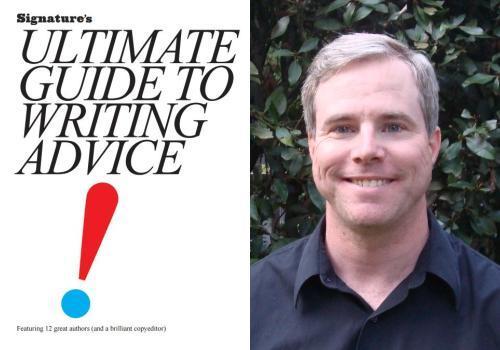
Are you struggling with getting the first words of your novel down on that intimidating blank page (or screen)? This year, Signature has put together the Ultimate Guide to Writing Advice to help you on your noveling journey. This guide is full to the brim of successful, well-known authors sharing their wit and wisdom. Today, we’re sharing an excerpt written by Andy Weir, author of The Martian, about getting past that dreaded first sentence. If you like what you read, the full Signature writing guide is available to download here.
In your mind, your novel is an epic tale that will redefine a genre. Fans will cosplay your characters. The internet will argue about which plot twist was the most awesome. George R. R. Martin will come knocking on your door for narrative advice. It’s that good. But when you try to actually write the damn thing, you freeze up. How can this be? You have the setting defined in excruciating detail. You could fill an encyclopedia with information about the protagonist’s childhood. You have the next six books in the series all planned out. Why can’t you squeeze out a single sentence?
You’re not alone. Every author faces this. The transition from ideal to reality is a rocky one. Every story is unique, so there’s no magic answer. But there are a few tips that might help you to defeat the tyranny of the blank page.
1. The purpose of the first line is to capture the reader.You have one sentence to convince the reader to finish the first paragraph. You have that paragraph to make them read the first page. If they turn the page, you’ve got them for a chapter. So make that first line interesting. It doesn’t have to be a major plot point. It just has to make them want to read the next line. The easiest way to do that is to tease the reader with a small mystery. “It was a bright cold day in April, and the clocks were striking thirteen” (1984, by George Orwell). An opening like that raises questions. Readers are inquisitive souls. If you make them wonder about something, they’ll read on to find the answer. Hook them with their own curiosity.
2. Don’t start with exposition.Nothing makes readers close a book faster than a long opening paragraph describing a mountain range.
Reading exposition is like doing homework or paying taxes. The reader accepts that they will have to learn this stuff at some point, but it’s usually not rewarding for them, in and of itself. It’s an investment made with the understanding that it’s critical to the story–one that readers are only willing to make after you’ve got them invested in the story itself. The Hobbit takes place in one of the most nuanced, well-defined settings ever created. Tolkien invented legends, languages, songs, and thousands of years of history. But instead of trying to ram all that down the reader’s throat, the book begins with: “In a hole in the ground there lived a hobbit.”
3. Feel free to start in the middle.If you don’t know where to start, don’t bother deciding right now. The first line of a book is critical, but there’s no rule that says you have to start there. The first words you write might end up being the middle of chapter three. That’s perfectly fine. And as you work forward in the story, you’ll get an idea about how to work backward. Once your characters develop and the plot grows in directions you didn’t expect, you may see the perfect scene to start things off with.
4. Bungle your way through.It’s easy to get stuck worrying about the nuances of the first scene. Instead, try writing as if you were telling the story to a friend. It’s okay if it sucks. You can edit it later. You may even find a better spot to start the story. The trick is to get things flowing.
Give it a try. Open your word processor right now and write one sentence, just one, that describes an action taken by the main character. Even if it’s “John drank his coffee,” you’ve gotten your start. Move on from there, make no effort to be any good, and narrate as if you were talking to a friend: “John drank his coffee. He didn’t know Ruth had poisoned it because she wanted him dead so she could run off with his business partner. Ruth’s his wife. See, the reason she did that was because she thought John had cheated on her, but actually he was investigating an insurance fraud …” Clumsy, awkward, and terrible to read. But after a few sentences, your first line becomes clear: “John drank his poisoned coffee.” Your reader now wants to know more.
Andy Weir was first hired by a national laboratory at age 15 and has been working as a software engineer ever since. He is also a lifelong space nerd and devoted hobbyist of subjects like relativistic physics, orbital mechanics, and the history of manned space flight. The Martian, adapted for film by Ridley Scott, is his first novel.
November 1, 2016
30 Covers, 30 Days 2016: Day One

Every November, during National Novel Writing Month, thirty professional designers volunteer to create book cover art inspired by novels being written by aspiring authors from around the globe. Why? To encourage new, diverse voices, and help build a more creative world.
30 Covers, 30 Days is presented in partnership with designer and author Debbie Millman.
Read more about these NaNoWriMo 2016 novels-in-progress, and the cover designers, below.
Hunter’s MoonA fantasy novel being written this November by Brielle Bishop & Charlie Nelsonin the Czech Republic.
Elise Dubois just wanted to graduate.
The final internship sounded simple enough: go out into the wilderness, kill an eldritch creature that considers two football teams a nice little snack, and come back with untold riches and lifetime bragging rights.
The problem isn’t that no one has ever returned. It’s that she’s not supposed to exist in the first place, let alone embark on a high-profile quest.
As she joins three others for her career-defining moment, she will learn much more than she ever needed–or wanted–to know about her world.
Cover Designed by Andrew Twigg
Andrew Twigg is an designer, educator, and entrepreneur. He likes color, the internet, Nutella, burritos, volleyball, and biking. Oh, and design. He’s the treasurer of AIGA, the professional association for design and is Assistant Teaching Professor at The School of Design at Carnegie Mellon University in Pittsburgh. You can find him on twitter at @andrewtwig.
Artist and author Jenny Williams has hand-lettered quotes from...
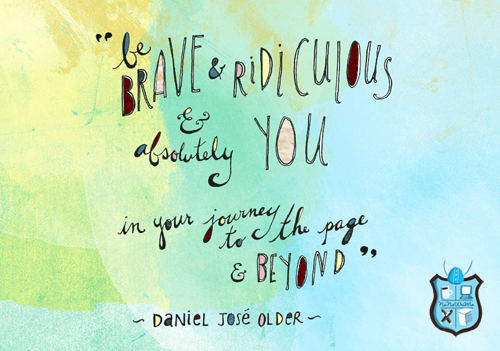
Artist and author Jenny Williams has hand-lettered quotes from this year’s Pep Talks! Check out her work at www.jennydwilliams.com, or follow her on Instagram @stateofwander. Read the rest of Daniel José Older’s pep talk here.
October 31, 2016
Road Trip to NaNo: Storytelling with Enthusiasm
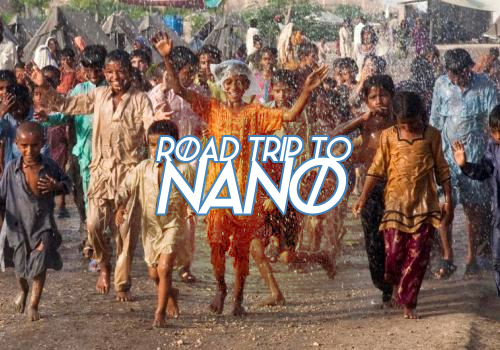
NaNoWriMo is an international event, and we’re taking a Road Trip to NaNo to hear about the stories being written every year in our hundreds of participating regions. Today, Slay Belle, our Municipal Liaison in the Asia :: Pakistan region, shows that, although quantity matters most for your word count, this doesn’t necessarily extend to the number of writers in your region:
Last year was my first as Pakistan’s Municipal Liaison. Our region is small and, prior to 2015, not very active. When the previous ML didn’t renew her spot, I volunteered for the position out of largely selfish reason–having recently relocated to Pakistan, I was desperately missing the camaraderie of fellow writers and thought this would be a great way for me to meet other authors. I knew a lot about NaNo, but as a foreigner, I hadn’t yet made my way into the creative community. To offset this, I contacted the incredible Desi Writer’s Lounge, a group offering support to South Asian writers, to team up for the 2015 NaNoWriMo. I’d provide the organizing; they’d bring the writing community.
“Pakistan has a strong oral literary tradition, with poetry, singing, and epic storytelling still alive and well. Almost everyone knows a poet, if they’re not one themselves.”
And bring they did. Our weekly Karachi based write-ins brought dozens of people out for word wars and timed sprints. The Islamabad DWL’ers were so successful at their write-ins, they ended up meeting almost daily. We gave out stickers for the most words written in a sprint and stickers for the least, we had cake and coffee and commiserated over our output and cheered each other on as one by one people began crossing the finish line. By other regions standards, our small group is not very numerically impressive – we had 23 confirmed winners last year, up significantly from earlier years, and 114 active participants–but numbers are only part of the story. The enthusiasm for creating, for putting stories down on paper, for supporting other writers doing the same–that far outweighs the number of people we had sign up.
Pakistan has a strong oral literary tradition, with poetry, singing, and epic storytelling still alive and well. Almost everyone knows a poet, if they’re not one themselves. Folklore and myths figure heavily in the literary scene, which in turn has influenced a strong speculative fiction tradition–in 2014, author Usman T Malik became the first Pakistani to win a Bram Stoker award for Short Fiction. Among our active Wrimos, half of them were working on various science fiction or fantasy epics. Stories with social justice themes are also popular, as well as tales celebrating or wrestling with issues of national identity.
In preparation for NaNo this year, we’ve already held a small workshop on plotting and planning. While we attracted a few new writers for this one-off, the majority of the attendees were returning. During the workshop it quickly became apparent that many of them – and myself as well – were suffering from the post-enthusiasm slump, or the dreaded ‘Now Whats’. Now that they knew how challenging November can be and the shiny newness of their first successful NaNo behind them, they wanted to know how they could be better prepared this time around.
I’ve given them an assignment to finish before our kick-off party, so maybe you’d like to try it too:The one-sentence exercise: You need to be able to sum up the purpose of your novel in one complete sentence. This is often the easiest way to tell the difference between having an idea and having a plot. An idea is great! We all love them! But ideas need to be worked into a plot or you’ll end up with a novel of interesting scenes and no connective tissues. The one sentence summary should include character, conflict, and quest. It may also include setting, action, or stakes.
Complete this exercise with us: When character stumbles into conflict, they must successfully complete quest, or stakes.
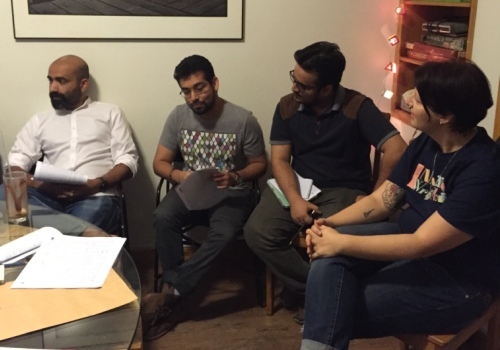
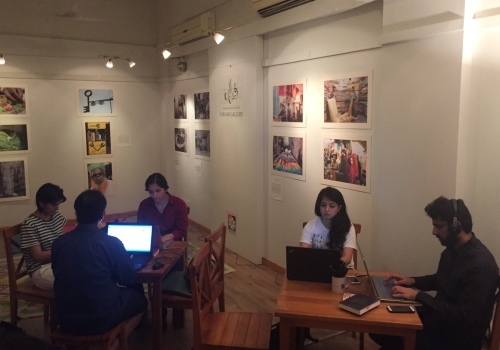

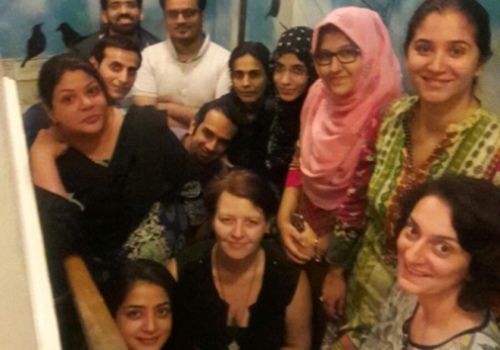

Slay Belle is the Municipal Liaison for the Pakistan region and has been a NaNoWriMo member since 2007. She’s a founding editor and new writer mentor for Persephone Magazine, and former editor for Jezebel’s Powder Room. Writing bios are not her thing, but her quirky character trait is a deep and abiding love for horror movies, which she can talk about exhaustively until someone politely changes the subject.
Top photo by Flickr user Roberto Saltori.
Chris Baty's Blog
- Chris Baty's profile
- 63 followers



